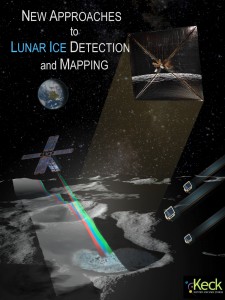Future Moon exploration and exploitation of lunar ice can benefit greatly by the use of a range of small satellites, according to a new study. Furthermore, university involvement will be essential to rein in costs.
The research findings are contained in the report – “New Approaches to Lunar Ice Detection and Mapping” – sponsored by Caltech’s Keck Institute for Space Studies (KISS).
The primary objective of the study was to explore innovative, low-cost mission concepts for detecting and mapping “operationally useful” ice deposits on the Moon, defined as those accessible to surface landers or rovers.
Orbiting spacecraft, impactor probes, penetrator probes, as well as landers and rovers were appraised.
Study participants found that small satellites were particularly well suited to the envisioned orbiter and impactor mission designs.
“While fulfilling these priorities will be an ambitious undertaking, we conclude that cost should not be prohibitive, as long as university involvement remains strong,” the report explains.
Recent advances
In releasing the report, study leaders, Paul Hayne (Jet Propulsion Laboratory), David Paige (University of California, Los Angeles), and Andrew Ingersoll (California Institute of Technology), and on behalf of 33 co-authors from 15 separate institutions, said that the study began in July 2013, with a closing workshop held in November.
The study was motivated by recent advances in two areas:
– Remote sensing data and models provide compelling (though sometimes conflicting) evidence for the presence of concentrated volatiles on the Moon.
– Small, low-cost spacecraft have emerged as a potentially viable means of planetary exploration and science.
Innovative, low-cost
The study team leaders observed: “We therefore sought to identify key measurements for lunar ice detection and mapping that could be accomplished through innovative, low-cost mission concepts.”
“We hope that this report will serve as a resource for the lunar (and broader planetary) science and exploration community. In particular, the report summarizes the current state of knowledge about lunar volatiles, and identifies future measurement approaches that could clarify their abundance, composition, and distribution. The mission concepts presented are a small subset of those considered in the study, and are those we found most compelling and/or technically mature,” they concluded.
For access to the full report, go to:
http://kiss.caltech.edu/study/lunar-ice/KISS_lunar_report.pdf
By Leonard David

